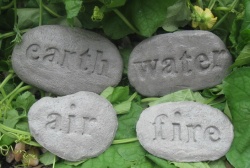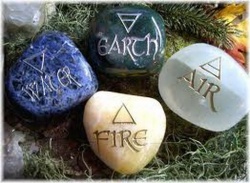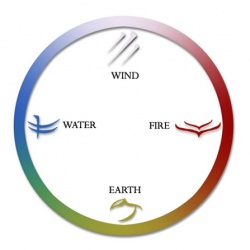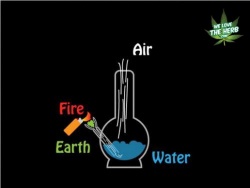Difference between revisions of "Mahābhūta"
m (Text replacement - "]]]" to "]])") |
|||
| (19 intermediate revisions by 5 users not shown) | |||
| Line 1: | Line 1: | ||
[[File:53864228.jpg|thumb|250px|]] | [[File:53864228.jpg|thumb|250px|]] | ||
| − | |||
| − | |||
| − | |||
| − | |||
| − | |||
| − | |||
| − | + | [[Mahābhūta]] is [[Sanskrit]] and [[Pāli]] for "[[great element]]." | |
| − | The same Upanishad also mentions, "When earth, water fire, air and akasa arise, when the five attributes of the elements, mentioned in the books on yoga, become manifest then the yogi's body becomes purified by the fire of yoga and he is free from illness, old age and death." (Verse 2.12). | + | In [[Buddhism]], the "[[four great elements]]" ([[Pali]]: [[cattāro mahābhūtāni]]) are [[earth]], [[water]], [[fire]] and [[air]]. [[Hinduism]] adds a fifth "great" or "gross" [[element]], [[akasha]] or [[aether]]. |
| + | |||
| + | |||
| + | == [[Hinduism]] == | ||
| + | |||
| + | |||
| + | In {{Wiki|Hinduism}}'s [[sacred]] {{Wiki|literature}}, the "great" or "gross" [[elements]] ([[mahābhūta]]) are fivefold: [[space]] (or "{{Wiki|ether}}"), [[air]], [[fire]], [[water]] and [[earth]]. | ||
| + | |||
| + | For instance, the [[Taittirīya Upaniṣad]] describes the five "sheaths" of a [[person]] ([[Sanskrit]]: [[puruṣa]]), starting with the grossest level of the five evolving [[great elements]]: | ||
| + | |||
| + | |||
| + | : From this very [[self]] ([[ātman]]) did [[space]] come into [[being]]; from [[space]], [[air]]; from [[air]], [[fire]]; from [[fire]], the waters, from the waters, the [[earth]]; from the [[earth]], [[plants]]; from [[plants]], [[food]]; and from [[food]], man.... Different from and {{Wiki|lying}} within this man formed from the [[essence]] of [[food]] is the [[self]] ([[ātman]]) consisting of lifebreath.... Different from and {{Wiki|lying}} within this [[self]] consisting of [[breath]] is the [[self]] ([[ātman]]) consisting of [[mind]].... Different from and {{Wiki|lying}} within this [[self]] consisting of [[mind]] is the [[self]] ([[ātman]]) consisting of [[perception]].... Different from and {{Wiki|lying}} within this [[self]] consisting of [[perception]] is the [[self]] ([[ātman]]) consisting of [[bliss]].... | ||
| + | |||
| + | |||
| + | In the [[Śvetāśvatara Upaniṣad]], [[God]] is identified as the source of the [[great elements]]: | ||
| + | |||
| + | |||
| + | : Some [[wise]] men say it is [[inherent]] [[nature]], while others say it is [[time]] – all totally deluded. | ||
| + | |||
| + | It is rather the greatness of [[God]] {{Wiki|present}} in the [[world]] by means of which this [[wheel]] of [[brahman]] goes around. | ||
| + | |||
| + | Who always encompasses this whole [[world]] – [[the knower]], the {{Wiki|architect}} of [[time]], the one without qualities, and the [[all-knowing one]] – it is at his command that the work of creation, to be [[conceived]] of as [[earth]], [[water]], [[fire]], [[air]], and [[space]], unfolds itself. | ||
| + | |||
| + | |||
| + | The same {{Wiki|Upanishad}} also mentions, "When [[earth]], [[water]] [[fire]], [[air]] and [[akasa]] arise, when the five [[attributes]] of the [[elements]], mentioned in the [[books]] on [[yoga]], become [[manifest]] then the [[yogi's]] [[body]] becomes [[purified]] by the [[fire]] of [[yoga]] and he is free from {{Wiki|illness}}, [[old age]] and [[death]]." (Verse 2.12). | ||
| + | |||
| + | |||
| + | == [[Buddhism]] == | ||
| + | |||
| + | |||
| + | In [[Buddhism]], the four [[Great Elements]] ([[Pali]]: [[cattāro mahābhūtāni]]) are [[earth]], [[water]], [[fire]] and [[air]]. | ||
| + | |||
| + | [[Mahābhūta]] is generally {{Wiki|synonymous}} with [[catudhātu]], which is [[Pāli]] for the "[[Four Elements]]." | ||
| + | |||
| + | In [[early Buddhism]], the [[Four Elements]] are a basis for [[understanding]] and for liberating oneself from [[suffering]]. | ||
| + | |||
| + | They are categories used to relate to the sensible [[physical world]], and are [[conceived]] of not as {{Wiki|substances}}, but as [[sensorial]] qualities. | ||
| − | |||
| − | |||
=== Definitions === | === Definitions === | ||
| + | |||
| + | |||
[[File:Stones.jpg|thumb|250px|]] | [[File:Stones.jpg|thumb|250px|]] | ||
| − | In the Pali canon, the most basic elements are usually identified as four in number but, on occasion, a fifth and, to an even lesser extent, a sixth element may be also be identified. | + | In the [[Pali canon]], the most basic [[elements]] are usually identified as four in number but, on occasion, a fifth and, to an even lesser extent, a sixth [[element]] may be also be identified. |
| − | ==== Four primary elements ==== | + | |
| + | |||
| + | ==== Four [[primary]] [[elements]] ==== | ||
| + | |||
| + | |||
| + | In {{Wiki|canonical}} texts, the [[four Great Elements]] refer to [[elements]] that are both "{{Wiki|external}}" (that is, outside the [[body]], such as a [[river]]) and "{{Wiki|internal}}" (that is, of the [[body]], such as {{Wiki|blood}}). | ||
| + | |||
| + | These [[elements]] are described as follows: | ||
| + | |||
| + | * [[Earth element]] ([[pruṭhavī-dhātu]]) | ||
| + | |||
| + | : Internal [[earth elements]] include {{Wiki|head}} [[hair]], [[body]] [[hair]], {{Wiki|nails}}, {{Wiki|teeth}}, {{Wiki|skin}}, flesh, sinews, bone, {{Wiki|organs}}, intestinal material, etc. | ||
| + | |||
| + | |||
| + | * [[Water]] (or liquid) [[element]]''' ([[āpa-dhātu]]) | ||
| + | : Internal [[water elements]] include {{Wiki|bile}}, {{Wiki|phlegm}}, pus, {{Wiki|blood}}, {{Wiki|sweat}}, fat, {{Wiki|tears}}, {{Wiki|nasal mucus}}, {{Wiki|urine}}, etc. | ||
| + | |||
| + | * [[Fire element]] ([[teja-dhātu]]) | ||
| + | : Internal [[fire elements]] include those [[bodily]] mechanisms that produce [[physical]] warmth, [[ageing]], {{Wiki|digestion}}, etc. | ||
| + | |||
| + | * [[Air]] (or [[wind]]) [[element]] ([[vāyu-dhātu]]) | ||
| + | : Internal [[air]] [[elements]] includes [[air]] associated with the pulmonary system (for example, for {{Wiki|breathing}}), the intestinal system ("[[winds]] in the belly and ... {{Wiki|bowels}}"), etc. | ||
| + | |||
| + | |||
| + | These four [[elements]] are described as "[[primary]]" or "underived" ([[no-upādā]]) [[matter]] ([[rūpa]]), [[meaning]] that they cannot be analysed into further atomistic units. | ||
| − | + | While underived, this does not mean that they are "[[unconditioned]]." | |
| − | + | [[Thus]], for instance, according to the 5th c. CE {{Wiki|commentarial}} [[Visuddhimagga]], "as to the proximate [[cause]], each ([[element]]) has the other three as its proximate [[cause]]." | |
| − | |||
| − | |||
| − | |||
| − | + | ==== Fifth and sixth [[elements]] ==== | |
| − | |||
| − | |||
| − | |||
| − | |||
| − | |||
| − | In addition to the above four elements of underived matter, two other elements are occasionally found in the Pali Canon: | + | In addition to the above four [[elements]] of underived [[matter]], two other [[elements]] are occasionally found in the [[Pali Canon]]: |
[[File:Gram2.JPG|thumb|250px|]] | [[File:Gram2.JPG|thumb|250px|]] | ||
| − | |||
| − | |||
| − | * | + | * [[Space]] [[element]] ([[ākāsa-dhātu]]) |
| − | : | + | : Internal [[space]] [[elements]] includes [[bodily]] orifices such as the {{Wiki|ears}}, nostrils, {{Wiki|mouth}}, anus, etc. |
| − | + | * '''[[Consciousness]] [[element]]''' ([[viññāṇa-dhātu]]) | |
| − | + | : Described as "[[pure and bright]]" ([[parisuddhaṃ pariyodātaṃ]]), used to [[cognise]] the three [[feelings]] ([[vedana]]) of [[pleasure]], [[pain]] and neither-pleasure-nor-pain, and the [[arising]] and passing of the [[sense]] [[contact]] ([[phassa]]) upon which these [[feelings]] are dependent. | |
| − | |||
| − | |||
| − | |||
| − | |||
| − | The Four Elements pertinence to the Buddhist notion of suffering comes about due to: | + | According to the [[Abhidhamma Pitaka]], the "[[space]] [[element]]" is identified as "secondary" or "derived" ([[upādā]]). |
| + | |||
| + | |||
| + | === {{Wiki|Sensory}} qualities, not {{Wiki|substances}} === | ||
| + | |||
| + | |||
| + | [[Rūpa]] ([[matter]]) means both [[materiality]] and sensibility—it {{Wiki|signifies}}, for example, a {{Wiki|tactile}} [[object]] both insofar as that [[object]] is {{Wiki|tactile}} and that it can be [[sensed]]. | ||
| + | |||
| + | [[Rūpa]] is never a [[materiality]] which can be separated or isolated from [[cognizance]]; such a non-empirical category is incongruous in the context of [[early Buddhism]]. [[Rūpa]] is not a [[substratum]] or [[substance]] which has {{Wiki|sensibility}} as a property. | ||
| + | |||
| + | It functions in early [[Buddhist]] [[thought]] as {{Wiki|perceivable}} physicality. [[Matter]], or [[rūpa]], is defined in terms of its [[function]]; what it does, not what it is. | ||
| + | |||
| + | As such, the four [[great elements]] are {{Wiki|conceptual}} {{Wiki|abstractions}} drawn from the sensorium. They are [[sensorial]] typologies, and are not [[Wikipedia:Metaphysics|metaphysically]] {{Wiki|materialistic}}. They are not meant to give an account of [[matter]] as constitutive of {{Wiki|external}}, mind-independent [[reality]]. | ||
| + | |||
| + | |||
| + | === {{Wiki|Soteriological}} uses === | ||
| + | |||
| + | |||
| + | The Four [[Elements]] are used in [[Buddhist texts]] to both elucidate the {{Wiki|concept}} of [[suffering]] ([[dukkha]]) and as an [[object]] of [[meditation]]. | ||
| + | |||
| + | The earliest [[Buddhist texts]] explain that the four [[primary]] material [[elements]] are the sensory qualities {{Wiki|solidity}}, {{Wiki|fluidity}}, temperature, and mobility; their characterisation as [[earth]], [[water]], [[fire]], and [[air]], respectively, is declared an {{Wiki|abstraction}} – instead of {{Wiki|concentrating}} on the fact of material [[existence]], one observes how a [[physical]] thing is [[sensed]], felt, [[perceived]]. | ||
| + | |||
| + | |||
| + | === [[Understanding]] [[suffering]] === | ||
| + | |||
| + | The [[Four Elements]] pertinence to the [[Buddhist]] notion of [[suffering]] comes about due to: | ||
[[File:Er-air.jpg|thumb|250px|]] | [[File:Er-air.jpg|thumb|250px|]] | ||
| − | |||
| − | * | + | * The [[Four Elements]] are the [[primary]] component of "[[form]]" ([[rūpa]]). |
| − | * | + | * "[[Form]]" is first category of the "[[Five Aggregates]]" ([[khandhas]]). |
| − | + | * The [[Five Aggregates]] are the [[ultimate]] basis for [[suffering]] ([[dukkha]]) in the "[[Four Noble Truths]]." | |
| − | : | + | Schematically, this can be represented in reverse [[order]] as: |
| − | + | :: [[Four Noble Truths]] → [[Suffering]] → [[Aggregates]] → [[Form]] → Four [[Elements]] | |
| − | |||
| − | + | [[Thus]], to deeply understand the [[Buddha's]] [[Four Noble Truths]], it is beneficial to have an [[understanding]] of the [[Great Elements]]. | |
| + | === [[Meditation]] [[object]] === | ||
| − | + | In the [[Mahasatipatthana Sutta]] ("The [[Greater Discourse on the Foundations of Mindfulness]]," DN 22), in listing various [[bodily]] [[meditation]] techniques, the [[Buddha]] instructs: | |
| − | + | : "...Just as if a [[skilled]] butcher or his assistant, having slaughtered a {{Wiki|cow}}, were to sit at a crossroads with the carcass divided into portions, so a [[monk]] reviews this very [[body]] ... in terms of the [[elements]]: 'There are in this [[body]] the [[earth-element]], the [[water-element]], the [[fire-element]], the [[air-element]].' So he abides contemplating [[body]] as [[body]] internally...." | |
| − | + | In the [[Visuddhimagga]]'s well-known list of forty [[meditation]] [[objects]] ([[kammaṭṭhāna]]), the [[great elements]] are listed as the first four [[objects]]. | |
| − | + | B. {{Wiki|Alan Wallace}} compares the [[Theravada]] [[meditative]] practice of "attending to the {{Wiki|emblem}} of [[consciousness]]" to the practice in [[Mahamudra]] and [[Dzogchen]] of "maintaining the [[mind]] upon non-conceptuality", which is also aimed at focusing on the [[nature]] of [[consciousness]]. | |
| − | In the Pali canon, the Four Elements are described in detail in the following discourses (sutta): | + | ===[[Buddhist]] sources=== |
| + | |||
| + | In the [[Pali canon]], the Four [[Elements]] are described in detail in the following [[discourses]] ([[sutta]]): | ||
[[File:Ater.jpg|thumb|250px|]] | [[File:Ater.jpg|thumb|250px|]] | ||
| − | |||
| − | |||
| − | |||
| − | The Four Elements are also referenced in: | + | * [[Mahahatthipadompama Sutta]] ("The [[Greater Discourse on the Simile of the Elephant's Footprint]]," MN 28) |
| + | * [[Maharahulovada Sutta]] ("The [[Greater Discourse of Advice to Rahula]]," MN 62) | ||
| + | * [[Dhatuvibhanga Sutta]] ("The [[Exposition of the Elements]]," MN 140) | ||
| + | |||
| + | The Four [[Elements]] are also referenced in: | ||
| − | * Kevaddha Sutta (DN 11) | + | * [[Kevaddha Sutta]] (DN 11) |
| − | * Mahasatipatthana Sutta (DN 22) | + | * [[Mahasatipatthana Sutta]] (DN 22) |
| − | * Satipatthana Sutta (MN 10) | + | * [[Satipatthana Sutta]] (MN 10) |
| − | * Chabbisodhana Sutta (MN 112) | + | * [[Chabbisodhana]] [[Sutta]] (MN 112) |
| − | * Bahudhatuka Sutta (MN 115) | + | * [[Bahudhatuka Sutta]] (MN 115) |
| − | * Kayagatasati Sutta (MN 119) | + | * [[Kayagatasati Sutta]] (MN 119) |
| − | * Anathapindikovada Sutta (MN 143) | + | * [[Anathapindikovada]] [[Sutta]] (MN 143) |
| − | * Catudhatu-vaggo (SN ch. 14, subch. IV), several discourses | + | * [[Catudhatu-vaggo]] (SN ch. 14, subch. IV), several [[discourses]] |
| − | * Saddhammapatirupaka Sutta (SN 16.13) | + | * [[Saddhammapatirupaka]] [[Sutta]] (SN 16.13) |
| − | * Bija Sutta (SN 22.54) | + | * [[Bija Sutta]] (SN 22.54) |
| − | * Asivisa Sutta (SN 35.197 or 35.238) | + | * [[Asivisa Sutta]] (SN 35.197 or 35.238) |
| − | * Kimsuka Sutta (SN 35.204 or 35.245) | + | * [[Kimsuka Sutta]] (SN 35.204 or 35.245) |
| − | * Dutiya-mittamacca Sutta (SN 55.17) | + | * [[Dutiya-mittamacca Sutta]] (SN 55.17) |
| − | * various brief Samyutta Nikaya discourses entitled, "Dhatu Sutta" (SN 18.9, SN 25.9, SN 26.9, SN 27.9) | + | * various brief [[Samyutta Nikaya]] [[discourses]] entitled, "[[Dhatu Sutta]]" (SN 18.9, SN 25.9, SN 26.9, SN 27.9) |
| − | * Tittha Sutta (AN 3.61) | + | * [[Tittha Sutta]] (AN 3.61) |
| − | * Nivesaka Sutta (AN 3.75) | + | * [[Nivesaka Sutta]] (AN 3.75) |
| − | * Rahula Sutta (AN 4.177) | + | * [[Rahula Sutta]] (AN 4.177) |
| − | In addition, the Visuddhimagga XI.27ff has an extensive discussion of the Four Elements. | + | In addition, the [[Visuddhimagga]] XI.27ff has an extensive [[discussion]] of the Four [[Elements]]. |
{{W}} | {{W}} | ||
| − | + | ||
| − | + | [[Category:Mahabhuta]] | |
| − | [[Category: | ||
Latest revision as of 23:11, 4 April 2016
Mahābhūta is Sanskrit and Pāli for "great element."
In Buddhism, the "four great elements" (Pali: cattāro mahābhūtāni) are earth, water, fire and air. Hinduism adds a fifth "great" or "gross" element, akasha or aether.
Hinduism
In Hinduism's sacred literature, the "great" or "gross" elements (mahābhūta) are fivefold: space (or "ether"), air, fire, water and earth.
For instance, the Taittirīya Upaniṣad describes the five "sheaths" of a person (Sanskrit: puruṣa), starting with the grossest level of the five evolving great elements:
- From this very self (ātman) did space come into being; from space, air; from air, fire; from fire, the waters, from the waters, the earth; from the earth, plants; from plants, food; and from food, man.... Different from and lying within this man formed from the essence of food is the self (ātman) consisting of lifebreath.... Different from and lying within this self consisting of breath is the self (ātman) consisting of mind.... Different from and lying within this self consisting of mind is the self (ātman) consisting of perception.... Different from and lying within this self consisting of perception is the self (ātman) consisting of bliss....
In the Śvetāśvatara Upaniṣad, God is identified as the source of the great elements:
It is rather the greatness of God present in the world by means of which this wheel of brahman goes around.
Who always encompasses this whole world – the knower, the architect of time, the one without qualities, and the all-knowing one – it is at his command that the work of creation, to be conceived of as earth, water, fire, air, and space, unfolds itself.
The same Upanishad also mentions, "When earth, water fire, air and akasa arise, when the five attributes of the elements, mentioned in the books on yoga, become manifest then the yogi's body becomes purified by the fire of yoga and he is free from illness, old age and death." (Verse 2.12).
Buddhism
In Buddhism, the four Great Elements (Pali: cattāro mahābhūtāni) are earth, water, fire and air.
Mahābhūta is generally synonymous with catudhātu, which is Pāli for the "Four Elements."
In early Buddhism, the Four Elements are a basis for understanding and for liberating oneself from suffering.
They are categories used to relate to the sensible physical world, and are conceived of not as substances, but as sensorial qualities.
Definitions
In the Pali canon, the most basic elements are usually identified as four in number but, on occasion, a fifth and, to an even lesser extent, a sixth element may be also be identified.
Four primary elements
In canonical texts, the four Great Elements refer to elements that are both "external" (that is, outside the body, such as a river) and "internal" (that is, of the body, such as blood).
These elements are described as follows:
- Internal earth elements include head hair, body hair, nails, teeth, skin, flesh, sinews, bone, organs, intestinal material, etc.
- Internal water elements include bile, phlegm, pus, blood, sweat, fat, tears, nasal mucus, urine, etc.
- Internal fire elements include those bodily mechanisms that produce physical warmth, ageing, digestion, etc.
- Air (or wind) element (vāyu-dhātu)
- Internal air elements includes air associated with the pulmonary system (for example, for breathing), the intestinal system ("winds in the belly and ... bowels"), etc.
These four elements are described as "primary" or "underived" (no-upādā) matter (rūpa), meaning that they cannot be analysed into further atomistic units.
While underived, this does not mean that they are "unconditioned."
Thus, for instance, according to the 5th c. CE commentarial Visuddhimagga, "as to the proximate cause, each (element) has the other three as its proximate cause."
Fifth and sixth elements
In addition to the above four elements of underived matter, two other elements are occasionally found in the Pali Canon:
- Described as "pure and bright" (parisuddhaṃ pariyodātaṃ), used to cognise the three feelings (vedana) of pleasure, pain and neither-pleasure-nor-pain, and the arising and passing of the sense contact (phassa) upon which these feelings are dependent.
According to the Abhidhamma Pitaka, the "space element" is identified as "secondary" or "derived" (upādā).
Sensory qualities, not substances
Rūpa (matter) means both materiality and sensibility—it signifies, for example, a tactile object both insofar as that object is tactile and that it can be sensed.
Rūpa is never a materiality which can be separated or isolated from cognizance; such a non-empirical category is incongruous in the context of early Buddhism. Rūpa is not a substratum or substance which has sensibility as a property.
It functions in early Buddhist thought as perceivable physicality. Matter, or rūpa, is defined in terms of its function; what it does, not what it is.
As such, the four great elements are conceptual abstractions drawn from the sensorium. They are sensorial typologies, and are not metaphysically materialistic. They are not meant to give an account of matter as constitutive of external, mind-independent reality.
Soteriological uses
The Four Elements are used in Buddhist texts to both elucidate the concept of suffering (dukkha) and as an object of meditation.
The earliest Buddhist texts explain that the four primary material elements are the sensory qualities solidity, fluidity, temperature, and mobility; their characterisation as earth, water, fire, and air, respectively, is declared an abstraction – instead of concentrating on the fact of material existence, one observes how a physical thing is sensed, felt, perceived.
Understanding suffering
The Four Elements pertinence to the Buddhist notion of suffering comes about due to:
- The Four Elements are the primary component of "form" (rūpa).
- "Form" is first category of the "Five Aggregates" (khandhas).
- The Five Aggregates are the ultimate basis for suffering (dukkha) in the "Four Noble Truths."
Schematically, this can be represented in reverse order as:
- Four Noble Truths → Suffering → Aggregates → Form → Four Elements
Thus, to deeply understand the Buddha's Four Noble Truths, it is beneficial to have an understanding of the Great Elements.
Meditation object
In the Mahasatipatthana Sutta ("The Greater Discourse on the Foundations of Mindfulness," DN 22), in listing various bodily meditation techniques, the Buddha instructs:
- "...Just as if a skilled butcher or his assistant, having slaughtered a cow, were to sit at a crossroads with the carcass divided into portions, so a monk reviews this very body ... in terms of the elements: 'There are in this body the earth-element, the water-element, the fire-element, the air-element.' So he abides contemplating body as body internally...."
In the Visuddhimagga's well-known list of forty meditation objects (kammaṭṭhāna), the great elements are listed as the first four objects.
B. Alan Wallace compares the Theravada meditative practice of "attending to the emblem of consciousness" to the practice in Mahamudra and Dzogchen of "maintaining the mind upon non-conceptuality", which is also aimed at focusing on the nature of consciousness.
Buddhist sources
In the Pali canon, the Four Elements are described in detail in the following discourses (sutta):
- Mahahatthipadompama Sutta ("The Greater Discourse on the Simile of the Elephant's Footprint," MN 28)
- Maharahulovada Sutta ("The Greater Discourse of Advice to Rahula," MN 62)
- Dhatuvibhanga Sutta ("The Exposition of the Elements," MN 140)
The Four Elements are also referenced in:
- Kevaddha Sutta (DN 11)
- Mahasatipatthana Sutta (DN 22)
- Satipatthana Sutta (MN 10)
- Chabbisodhana Sutta (MN 112)
- Bahudhatuka Sutta (MN 115)
- Kayagatasati Sutta (MN 119)
- Anathapindikovada Sutta (MN 143)
- Catudhatu-vaggo (SN ch. 14, subch. IV), several discourses
- Saddhammapatirupaka Sutta (SN 16.13)
- Bija Sutta (SN 22.54)
- Asivisa Sutta (SN 35.197 or 35.238)
- Kimsuka Sutta (SN 35.204 or 35.245)
- Dutiya-mittamacca Sutta (SN 55.17)
- various brief Samyutta Nikaya discourses entitled, "Dhatu Sutta" (SN 18.9, SN 25.9, SN 26.9, SN 27.9)
- Tittha Sutta (AN 3.61)
- Nivesaka Sutta (AN 3.75)
- Rahula Sutta (AN 4.177)
In addition, the Visuddhimagga XI.27ff has an extensive discussion of the Four Elements.




